Numerical Evaluation of Structural Safety for Aged Onshore Wind Foundation to Extend Service Life
Abstract
1. Introduction
2. Service Life Extension of Onshore Wind Foundation
2.1. Service Life Extension or Re-Use
2.2. Decision Making Process for Structural Safey Evaluation
2.3. Targeted Onshore Wind Foundation
3. Structural Safety Evaluation for Aged Wind Foundation
3.1. Concrete Material Test
3.2. Ultimate Strength
3.3. Fatigue Life
3.4. Soil Resistance, Overturning, and Sliding
3.5. Summary of Structural Safety Evaluation
4. Conclusions
Author Contributions
Funding
Acknowledgments
Conflicts of Interest
References
- Lantz, E.; Leventhal, M.; Baring-Gould, E.I. Wind Power Project Repowering: Financial Feasibility, Decision Drivers, and Supply Chain Effects; NREL/TP-6A20-60535; Office of Scientific and Technical Information (OSTI): Golden, CO, USA, 2013. [Google Scholar]
- European Wind Energy Association. Wind in Power–2015 European Statistics; EWEA: Brussels, Belgium, 2016. [Google Scholar]
- Connaghan, B.; DeCristofaro, E.; Soderlund, E.; Thibodeau, M.; Wang, X. White Paper: Wind Project Repowering; Sargent & Lundy: Chicago, IL, USA, 2017. [Google Scholar]
- DNV-GL. White Paper on Technical and Contractual Considerations in Partial Repowering of Wind Turbines; EAA-WP-07; DNV-GL: Oslo, Norway, 2016. [Google Scholar]
- He, M.; Bai, X.; Ma, R.; Huang, D.; Liu, H. Field experimental study on the retrofit of cracked onshore wind turbine foundations using externally prestressed anchor bolts. Struct. Concr. 2017, 19, 864–875. [Google Scholar] [CrossRef]
- Ziegler, L.; Elena Gonzalez, E.; Rubert, T.; Smolka, U.; Melero, J. Lifetime extension of onshore wind turbines: A review covering Germany, Spain, Denmark, and the UK. Renew. Sustain. Energy Rev. 2018, 82, 1261–1271. [Google Scholar] [CrossRef]
- U.S. Energy Information Administration. Annual Electric Generator Report; U.S. Energy Information Administration: Washington, DC, USA, 2016.
- Byrne, A. Trends, technical risks and opportunities in partial repowering. In Proceedings of the AWEA Wind Project O&M and Safety Conference 2017, San Diego, CA, USA, 28 February–1 March 2017. [Google Scholar]
- DeCristofaro, E.; Sargent & Lundy. Wind project partial repowering: Key considerings and insights. In Proceedings of the AWEA WindPower Conference 2018, Chicago, IL, USA, 7–10 May 2018. [Google Scholar]
- Waldron, S.; Smith, J.; Taylor, K.; McGinnes, C.; Roberts, N.; McCallum, D. Repowering onshore wind farms: A technical and environmental exploration of foundation reuse. In Carbon Landscape and Drainage Knowledge Exchange Network-Led Report; Construction Scotland Innovation Centre: Glasgow, UK, 2018. [Google Scholar]
- Salzgitter, A. K-Tower Repowering Concept. 2020. Available online: www.szmr.de/en/supply-program/system-solutions/k-tower/k-tower-repowering-concept.html (accessed on 20 May 2020).
- Hassanzadeh, M. Cracks in onshore wind power foundations: Causes and consequences. Elforsk 2012, 11, 56. [Google Scholar]
- ACI Committee 349. Code Requirements for Nuclear Safety-Related Concrete Structures and Commentary; American Concrete Institute: Farmington Hills, MI, USA, 2013. [Google Scholar]
- DNV-GL. Support Structures for Wind Turbines; DNVGL-ST-0126; DNV GL: Oslo, Norway, 2016. [Google Scholar]
- Japan Society of Civil Engineers. Guidelines for Structural Design of Supports for Wind Power Facilities; JSCE: Tokyo, Japan, 2010. [Google Scholar]
- Frits, C.W.; Peter, H.F. DIANA User’s Manual: Nonlinear Analysis-Release 7; TNO build. and construct.: Delft, The Netherlands, 1998. [Google Scholar]
- Song, S.; Jeong, Y.; Park, M.; Kim, J. Nonlinear structural analysis of embedded ring foundations for partial repowering of aging onshore wind turbines. J. Wind Energy 2019, 10, 35–42. [Google Scholar]
- ANSYS. ANSYS User’s Manual: Theory Reference Release 5.6; ANSYS Inc.: Bengaluru, India, 1999. [Google Scholar]
- DNV-GL. DNVGL RP-C203: Fatigue Design of Offshore Steel Structures; DNV-GL: Oslo, Norway, 2014. [Google Scholar]
- Fib International. Fib Model Code for Concrete Structures 2010; Fib International: Lausanne, Swiss, 2013. [Google Scholar]
- Hattori, T. Fatigue strength and life estimation methods using critical distance stress theory. Glob. J. Eng. Sci. 2019, 2, 1–9. [Google Scholar] [CrossRef]
- Gorash, Y.; MacKenzie, D. On cyclic yield strength in definition of limits for characterization of fatigue and creep behavior. Open Eng. 2017, 7, 126–140. [Google Scholar] [CrossRef]
- Isojeh, B.; Ei-Zeghayar, M.; Vecchio, F.J. Concrete damage under fatigue loading in uniaxial compression. ACI Mater. J. 2017, 144, 225–235. [Google Scholar] [CrossRef]
- Zhou, X.; Kong, H.; Dow, J.S. Failure case study of reinforced concrete foundations of wind turbine towers. Proc. Inst. Civ. Eng. Forensic Eng. 2015, 168, 158–166. [Google Scholar] [CrossRef]
- Kumar, A. Age consider; youth ventures: Considering for wind farm repowering. In New Zealand Wind Energy Conference 2017; DNV-GL: Oslo, Norway, 2017. [Google Scholar]
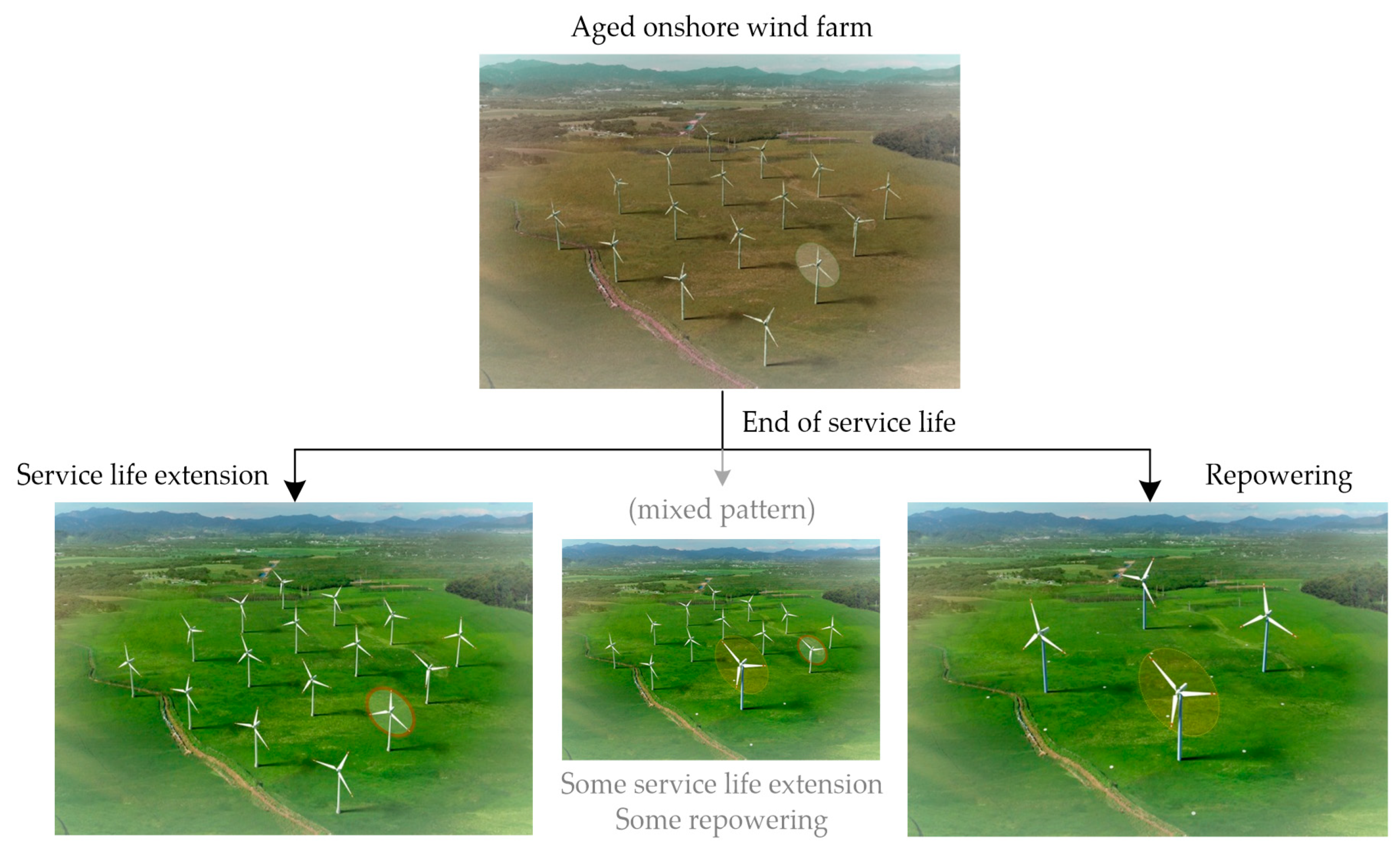
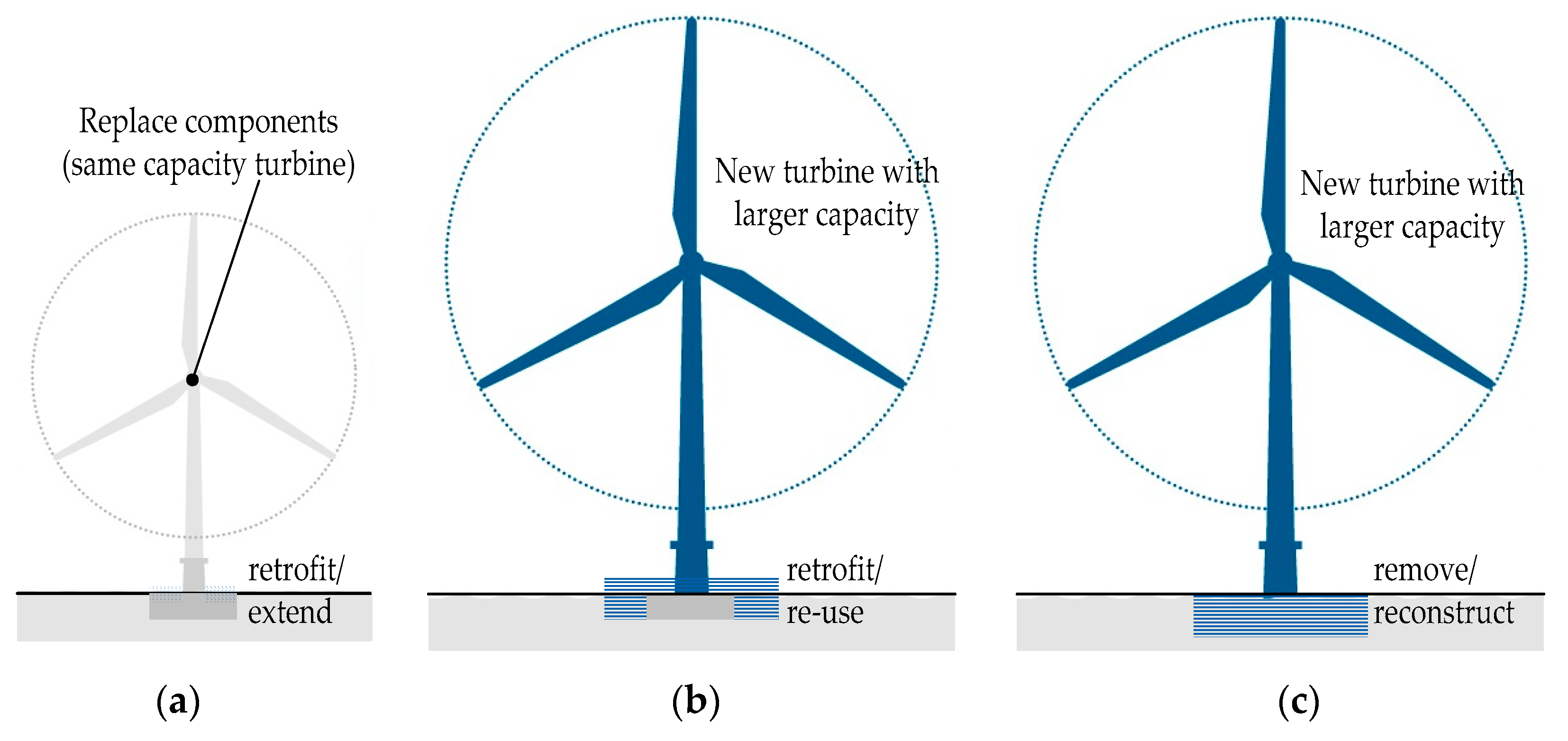
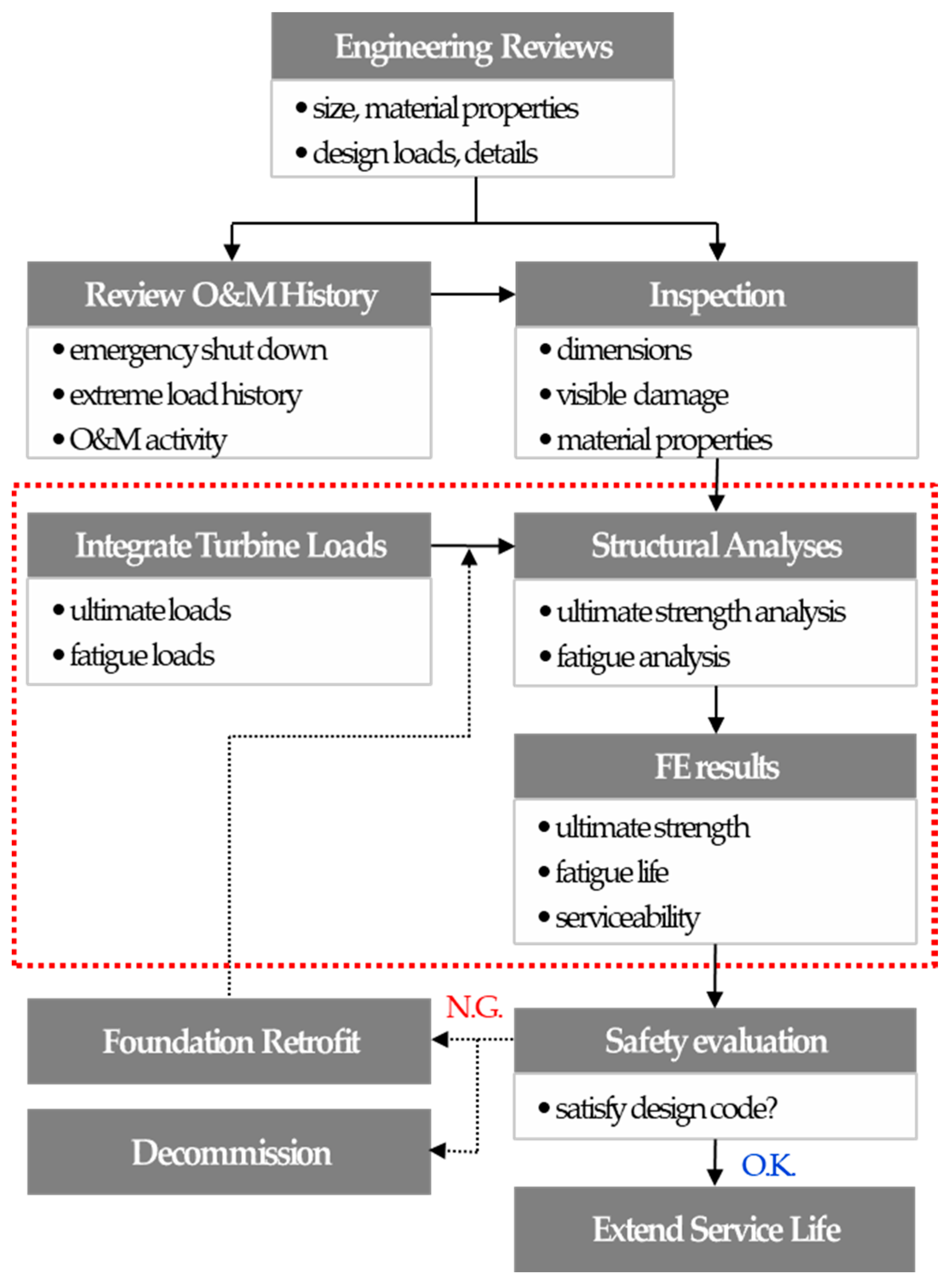
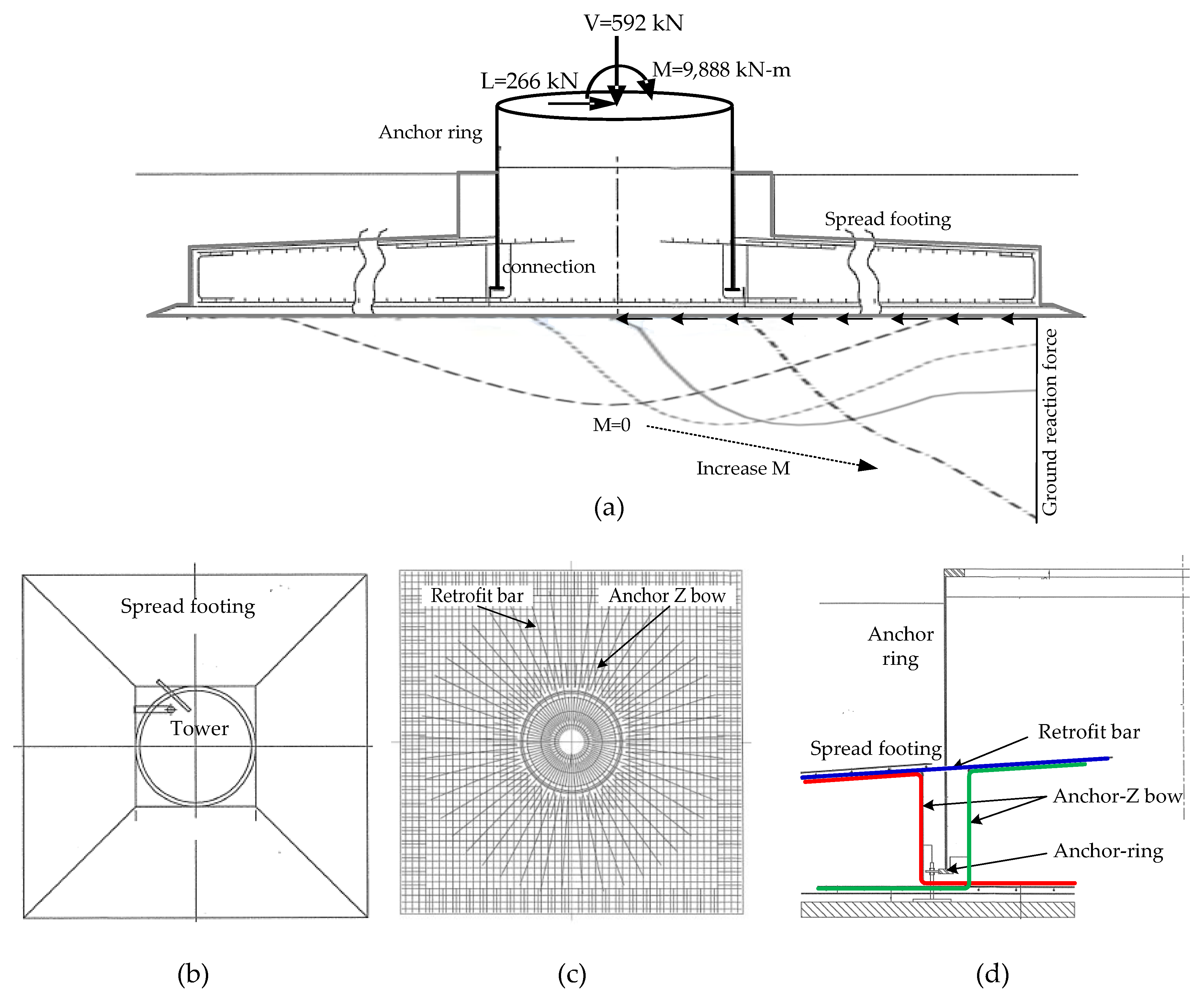

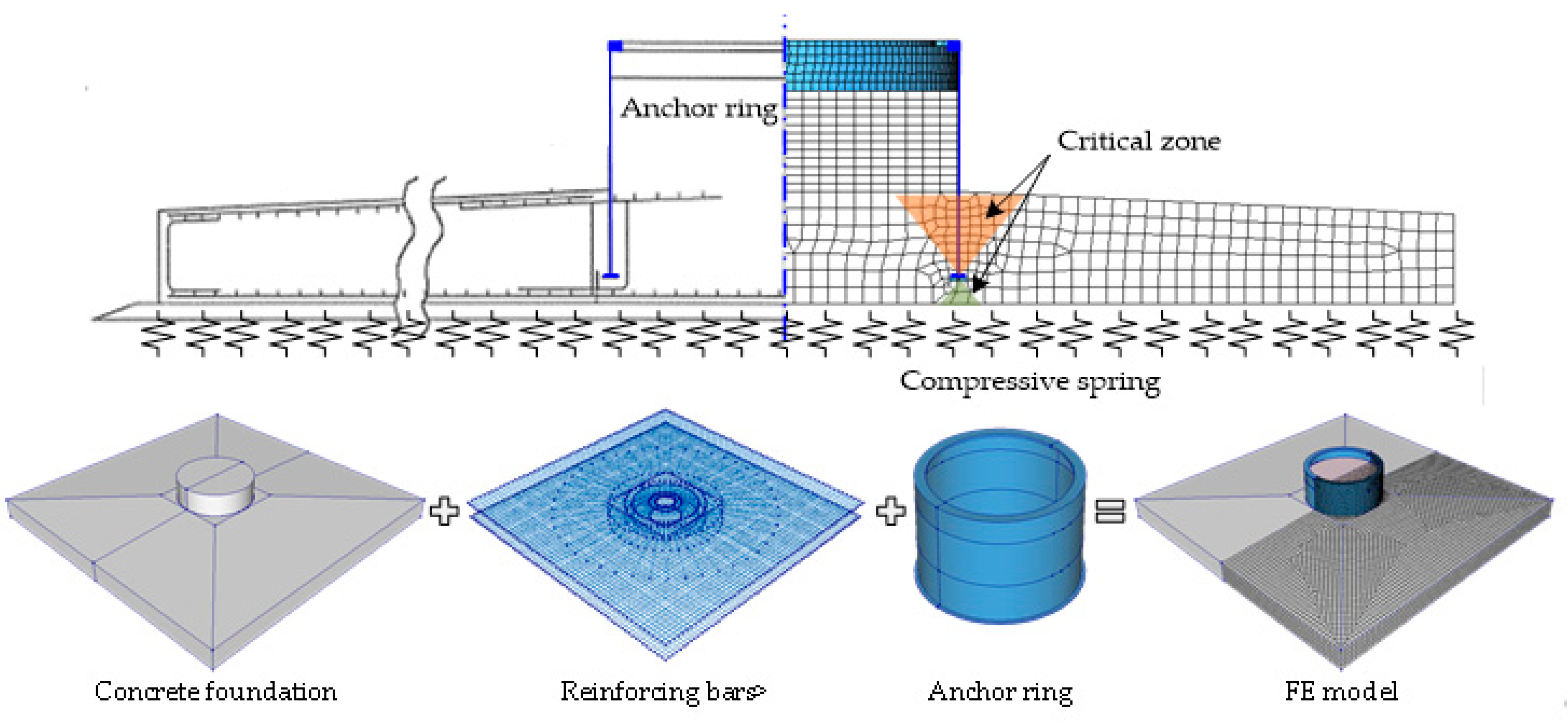
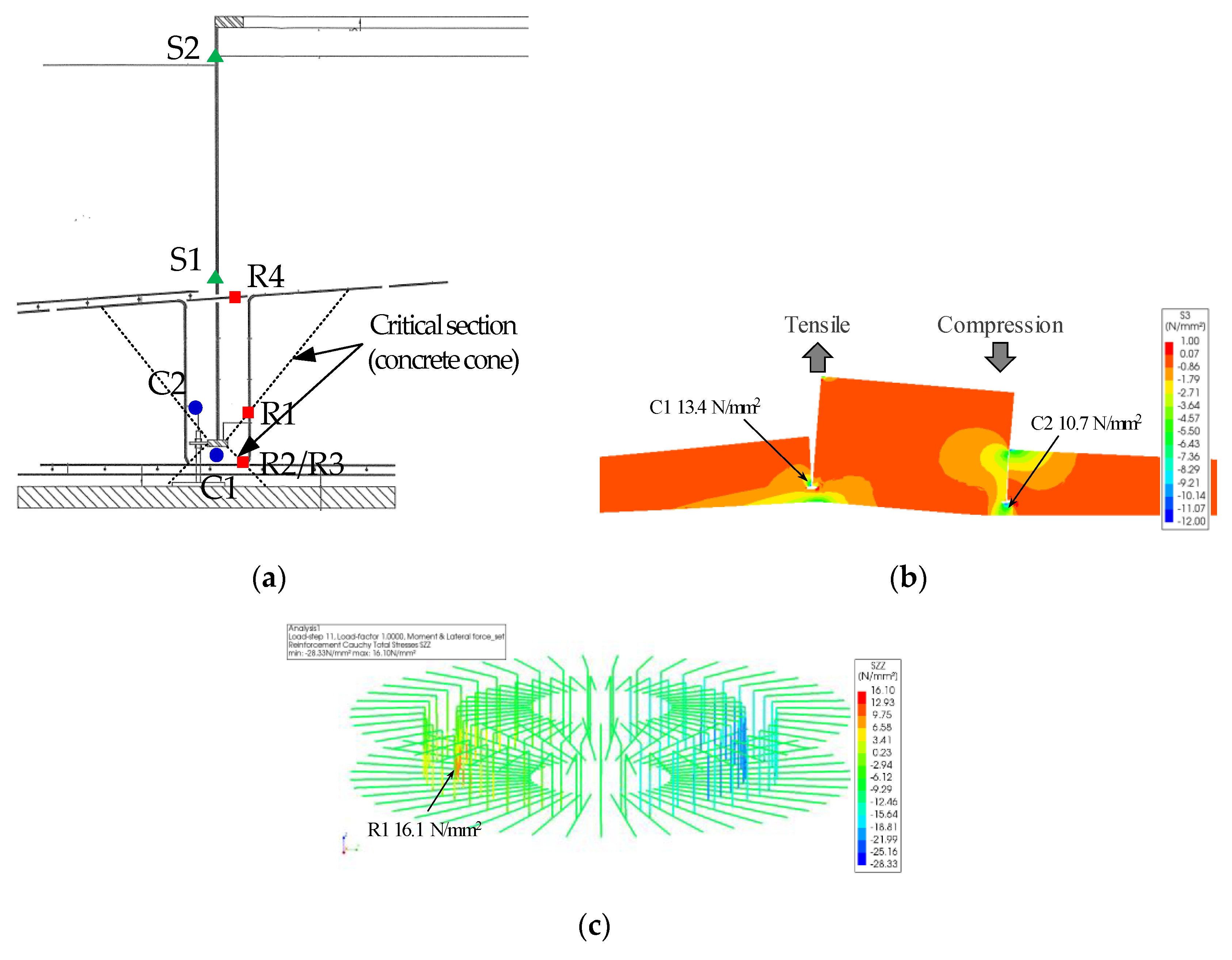
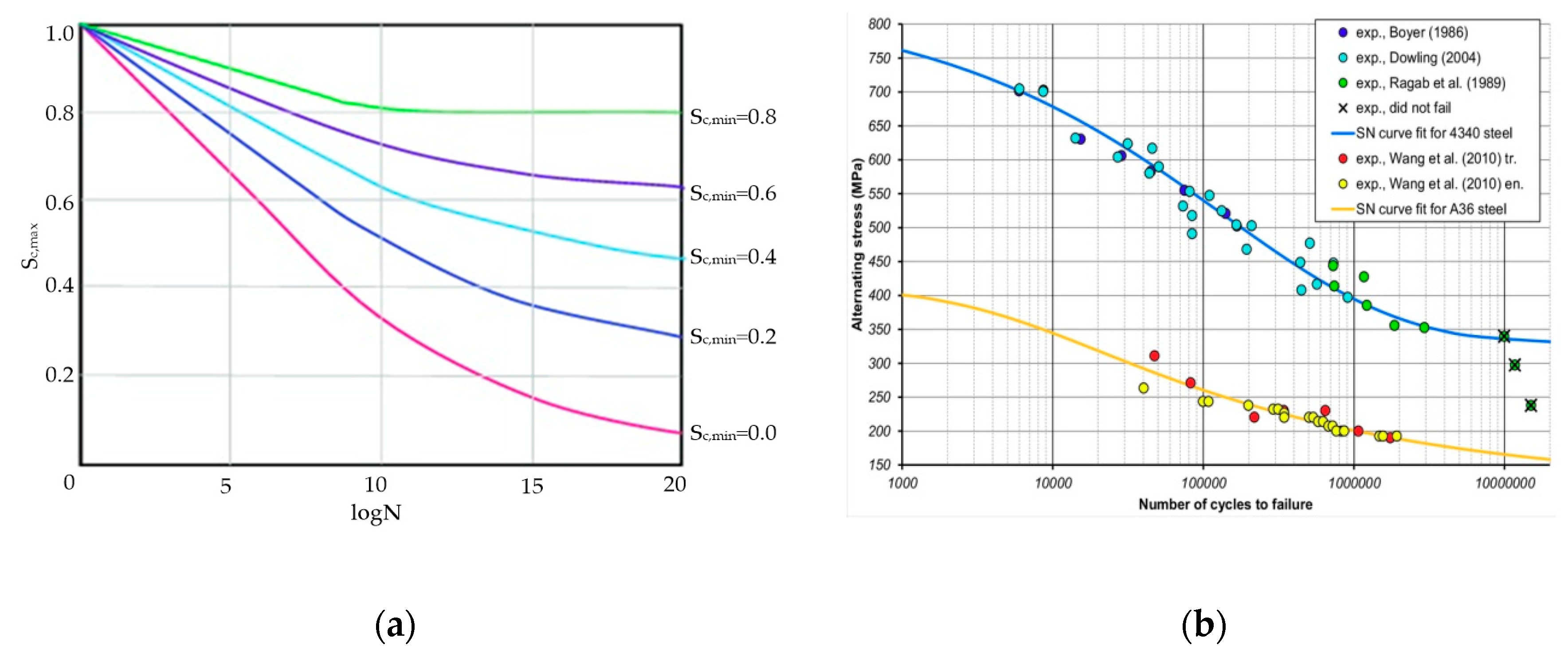

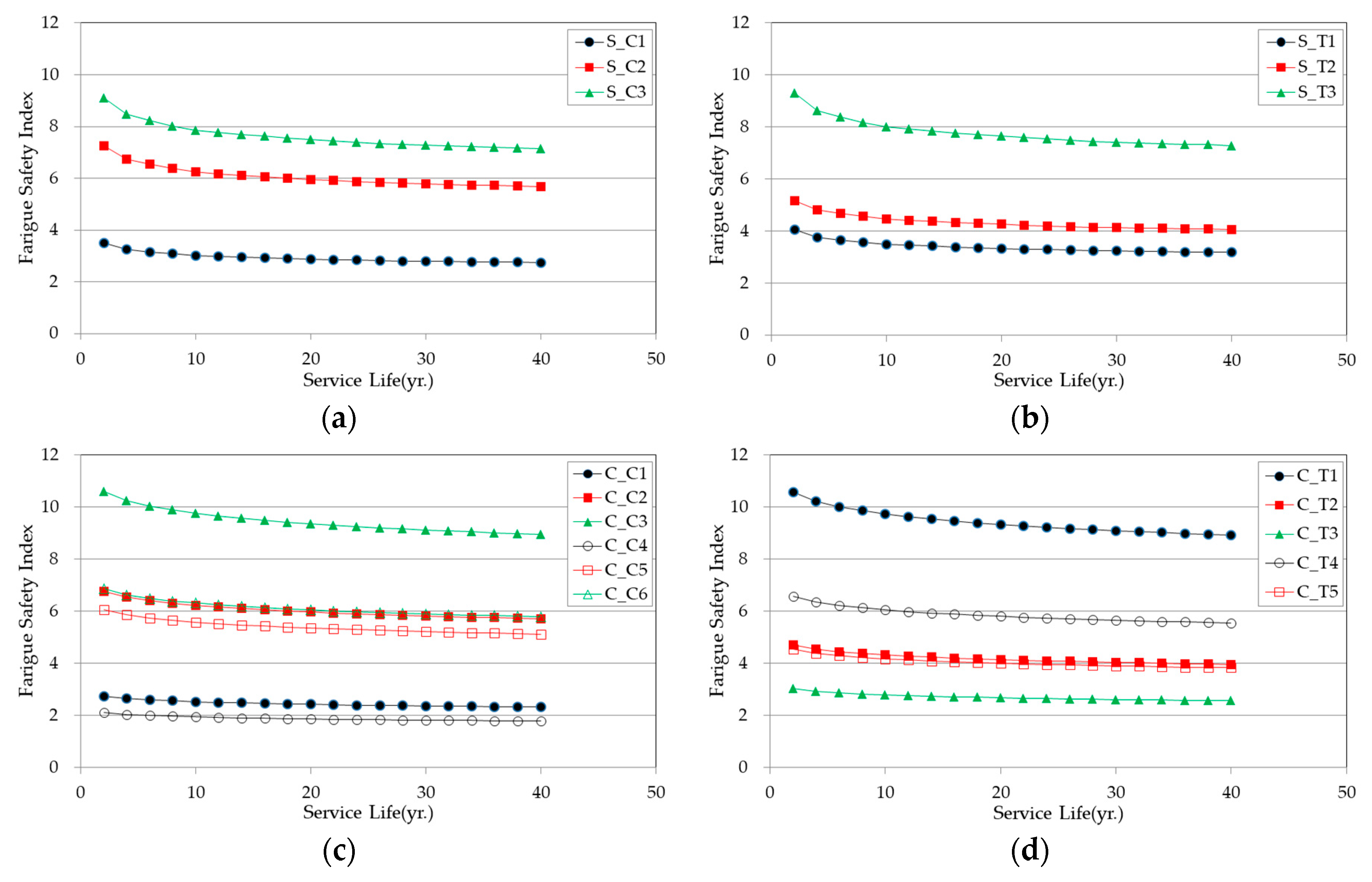
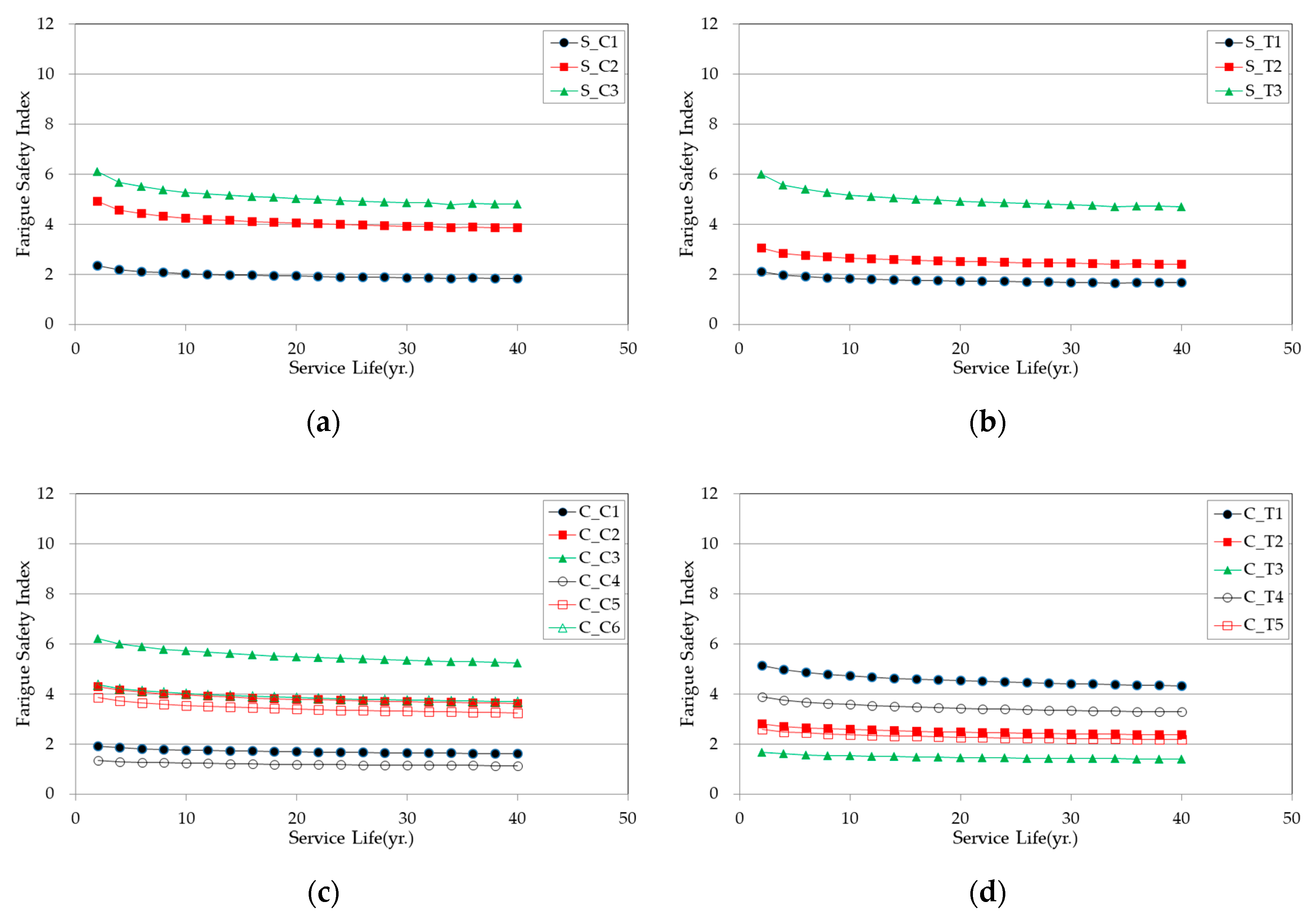
| Items | Specification |
|---|---|
| Turbine capacity | 660 kW |
| Hub height | 45 m |
| Bottom tower diameter | 3.0 m |
| Operation year | 2003 |
| Compressive Strength | Elastic Modulus | Tensile Strength | Fracture Energy | |
|---|---|---|---|---|
| Average | 40.6 MPa | 23,673 N/mm2 | 3.83 MPa | 0.143 N/mm |
| Concrete (MPa) | Reinforcement (MPa) | Anchor Ring (MPa) | ||||||
|---|---|---|---|---|---|---|---|---|
| C1 | C2 | R1 | R2 | R3 | R4 | S1 | S2 | |
| FE | 13.4 | 10.7 | 16.1 | 25.4 | 28.0 | 93.2 | 115.4 | 117.0 |
| Design | 40.6 | 400 | 240 | |||||
| Ratio | 0.33 | 0.26 | 0.04 | 0.06 | 0.07 | 0.23 | 0.48 | 0.49 |
| Inv. SN Slope | Mx (Nm) | My (Nm) | Mz (Nm) | Fx (N) | Fy (N) | Fz (N) |
|---|---|---|---|---|---|---|
| 3 | 3,420,000 | 3,840,000 | 910,039 | 109,040 | 134,288 | 32,875.3 |
| 5 | 6,160,000 | 5,780,000 | 1,380,000 | 171,883 | 286,862 | 33,917.7 |
| Items | 1. Material Strength (MPa) | 2. Ultimate Strength (MPa) | 3. Fatigue Life (yr.) | 4. Soil Resistance (kN/m2) | 5. Over Turning (kN-m) | 6. Sliding (kN) | ||
|---|---|---|---|---|---|---|---|---|
| Members | Concrete | concrete | steel | concrete | steel | |||
| Evaluation | 40.6 | 13.4 | 93.2 | > 40 yr. | > 40 yr. | 74.1 | 10,473 | 266 |
| Criteria | 30.0 | 40.6 | 240.0 | > 20 yr. | > 20 yr. | 200.0 | 21,881 | 2722 |
| Ratio | 1.35 | 0.33 | 0.49 | > 40 yr. | > 40 yr. | 0.37 | 0.48 | 0.10 |
© 2020 by the authors. Licensee MDPI, Basel, Switzerland. This article is an open access article distributed under the terms and conditions of the Creative Commons Attribution (CC BY) license (http://creativecommons.org/licenses/by/4.0/).
Share and Cite
Jeong, Y.-J.; Park, M.-S.; Song, S.-H.; Kim, J. Numerical Evaluation of Structural Safety for Aged Onshore Wind Foundation to Extend Service Life. Appl. Sci. 2020, 10, 4561. https://doi.org/10.3390/app10134561
Jeong Y-J, Park M-S, Song S-H, Kim J. Numerical Evaluation of Structural Safety for Aged Onshore Wind Foundation to Extend Service Life. Applied Sciences. 2020; 10(13):4561. https://doi.org/10.3390/app10134561
Chicago/Turabian StyleJeong, Youn-Ju, Min-Su Park, Sung-Hoon Song, and Jeongsoo Kim. 2020. "Numerical Evaluation of Structural Safety for Aged Onshore Wind Foundation to Extend Service Life" Applied Sciences 10, no. 13: 4561. https://doi.org/10.3390/app10134561
APA StyleJeong, Y.-J., Park, M.-S., Song, S.-H., & Kim, J. (2020). Numerical Evaluation of Structural Safety for Aged Onshore Wind Foundation to Extend Service Life. Applied Sciences, 10(13), 4561. https://doi.org/10.3390/app10134561







